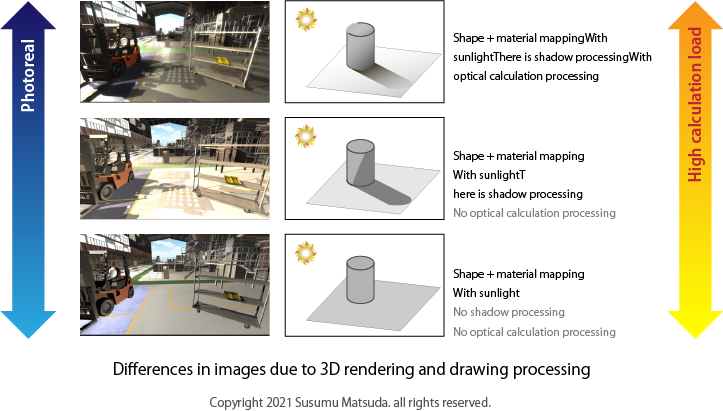If you think about safety using VR, you will run into problems. We will solve each of these issues. First is the construction of virtual space. It is necessary to create artificial structures such as towns, buildings, structures, goods, and roads constructed by humans in a realistic manner. By using the latest technology, it is possible to reproduce 3D shapes by 3D CAD data, photographs from multiple directions, and laser measurement. However, in order to process the acquired raw data in real time on a computer, the amount of calculation is large and it is necessary to simplify the data. Therefore, in reality, it is necessary to create virtual models one by one according to the purpose. The required realism is an environment reproduction without lies compared to the actual environment. We need a space that makes us think that it actually exists even in virtual space. Reality is often confused with “photorealistic” reproduction. Photoreal is not a very important element in the virtual experience. However, depending on the purpose of use, there are cases where virtual reproduction using photographs is required (things that do not make sense if they are different from the real world, such as virtual travel). To realize photorealism, the characteristics of shadows and light can be simulated to some extent in real time by improving the computing power of the computer. In order to efficiently reproduce the environment, it is necessary to prepare a 3D database environment (all shapes and natural environments existing on the earth) for real-time VR. By reusing high quality 3D data (in the case of man-made objects, there is no functional lie), we can reduce costs and increase development speed.

With the advancement of hardware, it is easy to reproduce the human field of view with VR goggles and the drawing ability of a computer. It responds to the movement and posture of a person, detects the movement and posture of a person by sensor tracking, and corrects the appearance of the image in real time with a computer to ensure an immersive feeling. These are realized by high-performance and inexpensive hardware due to technological advances. Next, if the 3D environment can be reproduced, it will be necessary to reproduce the environmental sounds related to the atmosphere of the environment. People judge 94% visually and soundly to perceive the environment. (Perception in a steady state without change is visual = about 83%, auditory = 11%) Sound is important as a judgment material for 11%.
From Mr.RiMM: This publication will be the final publication in 2021. 2022 is scheduled to be posted on January 12th.